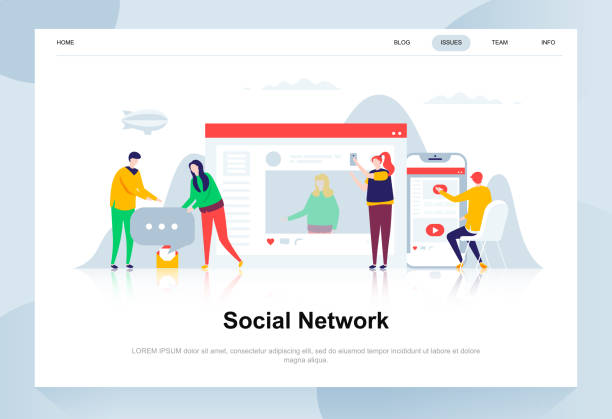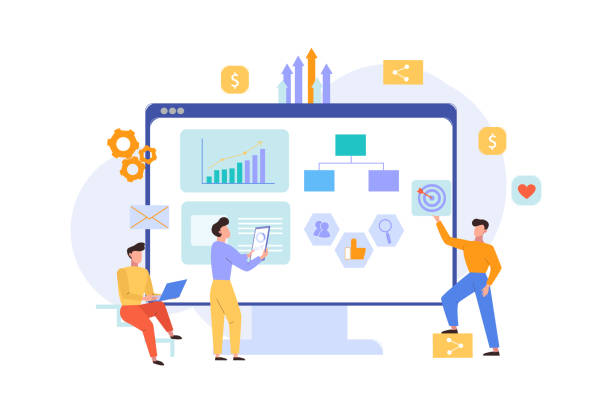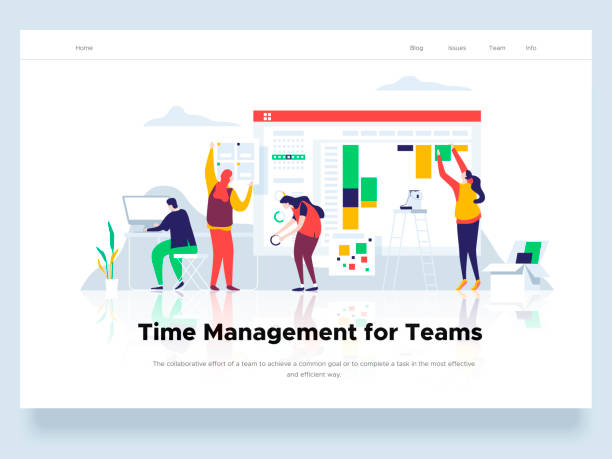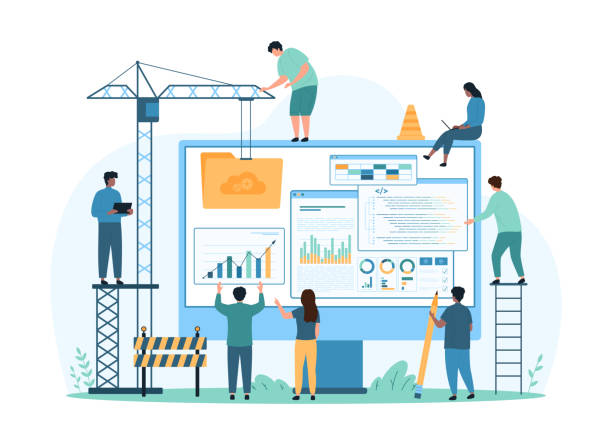Introduction to E-commerce Website Design and Its Importance in the Digital Age

In today’s world, where information and communication technology reigns supreme, having an online business and a strong presence in the virtual space is no longer an option, but an undeniable necessity.
E-commerce website design means creating an online platform for offering and selling products or services, which can revolutionize how businesses interact with their customers.
This platform not only removes time and location limitations but also provides access to a much wider market.
With the increasing number of internet users and their inclination towards online shopping, investing in #e_commerce and #online_stores has become a vital strategy.
A well-designed e-commerce website is not just a showcase for your products, but a powerful tool for marketing, attracting customers, and increasing sales.
The importance of e-commerce website design lies in its ability to provide 24/7 uninterrupted activity, reduce operational costs, and allow you to obtain valuable data on your customers’ behavior.
This data can significantly help you improve the shopping experience and increase conversion rates.
Therefore, for success in today’s competitive landscape, special attention to detail in e-commerce website design is an essential and indispensable step.
Does your current website inspire the trust that potential customers should have in your business? If the answer is no, it’s time to have your professional and impactful corporate website with Rasaweb.
✅ Fully custom design tailored to your brand identity
✅ Increased lead generation and business credibility in the eyes of customers⚡ Contact us for a free consultation!
Initial Steps in E-commerce Website Design: Planning and Research

Before entering the technical phase of e-commerce website design, precise planning and comprehensive research are of paramount importance.
This stage forms the fundamental basis for the success of your project.
First, you must accurately identify your target market.
Who are your customers? What are their needs? How can they be best reached? Answering these questions will illuminate the path for your online store design.
Second, competitor analysis is essential.
Who are your competitors? What are their strengths and weaknesses? What will differentiate you from them? This analysis helps you formulate unique strategies for building your e-commerce website.
Third, you must choose the right platform for your online store.
Are you looking for a ready-made platform like Shopify or WooCommerce, or do you need a custom solution? Each of these options has its own advantages and disadvantages that should be considered based on your budget, required scalability, and your team’s technical knowledge.
Choosing the correct platform at the outset prevents potential problems and costs in the future.
This stage also includes defining the exact features and functionalities required for the store, planning for content, and the overall site structure.
A comprehensive and documented plan not only serves as a roadmap for the e-commerce website design team but also helps you stay on track with your main goals and ultimately achieve a desired outcome.
Principles of User Interface (UI) and User Experience (UX) Design in Online Stores

User Interface (UI) and User Experience (UX) are two main pillars in the success of an e-commerce website that directly impact conversion rates and customer satisfaction.
UI design refers to the visual and interactive aesthetics of the site, including colors, fonts, layout, and graphic elements, while UX focuses on the ease of use, efficiency, and pleasure of the user’s experience when browsing and purchasing from the site.
The main goal in e-commerce website design with a UI/UX approach is to create an easy and pleasant path for the customer from the moment they enter the site until the completion of the purchase process.
Simple and intuitive navigation, product pages with comprehensive information and high-quality images, a transparent shopping cart, and a fast and hassle-free payment process are all key principles of UX.
Site loading speed, compatibility with mobile devices (responsiveness), and providing various options for searching and filtering products significantly improve the user experience.
Ultimately, powerful UI and UX design not only encourages customers to use your site but also makes them return and become loyal customers.
The following table highlights some of the best UI/UX practices in e-commerce website design:
| Element | Description |
|---|---|
| Clear Navigation | Simple menus and logical categories for easy product discovery. |
| Fast Loading Speed | Optimizing images and site code for quick page loading. |
| Responsive Design | Full site compatibility with all device types (mobile, tablet, desktop). |
| Simple Payment Process | Minimizing payment steps and transparent cost breakdown. |
| High-Quality Images | Providing multi-angle and zoomable product images. |
Choosing the Right Platform for E-commerce Website Design: Pros and Cons

One of the most important decisions in the e-commerce website design journey is choosing the right platform.
This choice not only affects implementation costs and time but also impacts the scalability, security, and future capabilities of your store.
Available platforms can be broadly categorized into two types: ready-made (SaaS) platforms and open-source platforms.
SaaS platforms like Shopify and BigCommerce are hosted solutions that require little technical knowledge.
Their main advantages are fast setup, ease of use, and strong technical support.
However, they also come with disadvantages such as limitations in customization, dependence on the service provider, and fixed monthly costs.
In contrast, open-source platforms like WooCommerce (for WordPress) and Magento offer much greater flexibility and control.
You can completely customize your store’s design and functionality and modify its code.
But this flexibility comes with the need for more technical knowledge, server management, and responsibility for security and maintenance.
For e-commerce website design, platform selection should be based on several factors such as budget, product volume, required complexity, and long-term plans for your business development.
Are you looking for a quick and hassle-free solution, or do you want complete control over all technical and visual aspects of your site? These questions will help you decide on building your online store.
Are you tired of your e-commerce website having visitors but no sales? Rasaweb solves your main problem with professional e-commerce website design!
✅ Significant sales increase with targeted design
✅ Flawless user experience for your customers
⚡ Get a free consultation!
Implementing Key Features in E-commerce Website Design

After choosing the right platform for e-commerce website design, it’s time to implement key features essential for the proper functioning and success of any online store.
The first and most important feature is product catalog management. A robust system for adding, editing, and categorizing products with the ability to include high-quality images, comprehensive descriptions, pricing, and inventory management is a cornerstone of any online store.
Second, integration of secure and diverse payment gateways.
This allows your customers to pay for products with confidence and using their preferred method (credit card, direct bank transfer, cash on delivery, etc.).
Transaction security is of paramount importance in this section.
Third, shipping management system and delivery options.
Customers expect to be able to view and choose shipping methods (post, courier, Tipax, etc.) and their associated costs.
Order tracking capability is also an important feature that improves the customer experience.
Fourth, customer account creation.
This feature allows customers to view their purchase history, save multiple addresses, and benefit from special discounts.
Finally, advanced search and filter functionality on the site is vital to help users quickly find the products they are looking for.
These features and many others form the main pillars of an efficient and customer-centric e-commerce website design and play a fundamental role in increasing user satisfaction and improving conversion rates.
Search Engine Optimization (SEO) for E-commerce Websites: Increasing Visibility

After the completion of your e-commerce website design, it’s time for it to be seen in search engines.
Search Engine Optimization (SEO) is a vital process for increasing organic traffic and attracting potential customers to your online store.
SEO for e-commerce sites is slightly different from content-based websites and requires special attention to detail.
First, technical SEO includes high loading speed, responsive design for mobile, and search engine-friendly URL structures, which are essential.
Using an SSL certificate and HTTPS protocol is also very important for site security and ranking.
Second, On-Page SEO involves researching keywords relevant to your products and strategically using them in page titles, meta descriptions, headings (H1, H2, etc.), and product descriptions.
Every product page should have unique and rich content.
Using optimized images with appropriate Alt tags and internal links between product and category pages also helps with on-page SEO.
Third, Off-Page SEO mainly involves building high-quality backlinks from reputable websites.
Also, active presence on social networks and encouraging product sharing can indirectly help SEO.
The goal of applying SEO principles in e-commerce website design is to appear higher in search results for keywords related to your products, thereby driving more targeted traffic to your online store.
This is an ongoing process and requires regular monitoring and updates.
Security and Maintenance of E-commerce Websites: Preventing Vulnerabilities

Security and continuous maintenance are two fundamental pillars for preserving the stability and customer trust in any e-commerce website.
Given the volume of sensitive information exchanged on an online store (such as customers’ personal information and payment details), data protection against cyber attacks and intrusions is of vital importance.
The first step is to use a valid SSL certificate, which encrypts communications between the user and the server and indicates your site’s security.
This is not only essential for customer trust but also positively impacts your site’s SEO ranking.
Second, regular updates of all plugins, themes, and the main store platform (such as WordPress and WooCommerce or Magento) to address known security vulnerabilities.
Many attacks occur due to the use of outdated versions with security holes.
Third, regular and automatic backups of the entire site (including files and database).
In case of any security or technical issue, these backups help you quickly restore the site.
Fourth, the use of a Web Application Firewall (WAF) and security tools to identify and block suspicious traffic and DDoS attacks.
Fifth, educating your team about security practices and awareness of phishing and social engineering threats.
Finally, continuous site monitoring to identify any suspicious activity and reviewing security reports are also important measures in maintaining the security of your e-commerce website.
These actions help maintain customer trust in your e-commerce website design and provide a secure shopping experience for them.
The following table provides a security checklist for an e-commerce website:
| Security Measure | Importance |
|---|---|
| Install SSL/TLS Certificate | Data encryption, increased user trust, and improved SEO. |
| Regular Platform and Plugin Updates | Fixing known security vulnerabilities. |
| Regular Backups | Ability to restore the site in case of an issue. |
| Use Strong Passwords | Protection of administrative and user accounts. |
| Activate Web Application Firewall (WAF) | Protection against SQL injection and XSS attacks. |
| Continuous Security Monitoring | Rapid identification of suspicious activities. |
Digital Marketing Strategies After E-commerce Website Design

After your e-commerce website design is complete and ready for operation, the next crucial step is attracting customers and increasing sales.
Digital marketing plays a key role at this stage and includes a set of strategies to drive targeted traffic to your online store.
One of the most effective methods is content marketing. Creating valuable content relevant to your products, such as blog articles, guides, videos, and infographics, not only helps with SEO but also builds customer trust.
Second, social media marketing.
An active presence on platforms like Instagram, Facebook, and LinkedIn allows for direct communication with the audience, showcasing products, and running targeted advertising campaigns.
Third, Pay-Per-Click (PPC) advertising through Google Ads or social media ads.
These methods enable you to quickly appear in search results or social feeds and attract immediate traffic.
Fourth, email marketing.
Collecting customer email addresses and sending newsletters, special offers, and product updates is a great way to maintain communication with customers and encourage repeat purchases.
Fifth, influencer marketing.
Collaborating with influential individuals in your field can help increase brand awareness and attract new customers.
All these strategies must work in an integrated and targeted manner to turn your e-commerce website design into a successful sales channel and accelerate your business growth.
Continuous monitoring and analysis of each marketing campaign’s performance are essential for optimization and improving ROI.
Did you know that a weak corporate website loses you many opportunities daily? With professional corporate website design by Rasaweb, solve this problem permanently!
✅ Create a powerful and trustworthy image for your brand
✅ Targeted attraction of new customers and increased sales
⚡ [Get a free website design consultation]
Data Analysis and Continuous Improvement in E-commerce Website Performance

After launching and operating your e-commerce website, your work doesn’t end; instead, you enter a new and vital phase of data analysis and continuous improvement.
Tools like Google Analytics, Google Analytics, and Google Search Console provide invaluable information about user behavior, traffic sources, conversion rates, popular pages, and site weaknesses.
By accurately analyzing this data, you can find answers to questions like: “Why do customers abandon the cart at a certain stage?” or “Which marketing channel generates the highest quality traffic?”
These analyses help you make more informed decisions to improve user experience, optimize the payment process, and increase sales.
Implementing A/B tests to compare different versions of a page or a specific element (e.g., the add-to-cart button) is also a powerful optimization tool.
By receiving direct feedback from users through surveys or user behavior tracking tools (like heatmaps), you can identify the strengths and weaknesses of your e-commerce website design.
The ultimate goal is to create a continuous cycle of data mining, testing, implementing changes, and re-monitoring.
This analytical approach ensures that your e-commerce website design is constantly evolving and improving, keeping pace with the changing needs of the market and your customers.
This is an endless process for achieving maximum efficiency and profitability.
The Future of E-commerce Website Design: New Trends and Leading Technologies

The world of e-commerce is constantly evolving and progressing, and e-commerce website design is no exception.
The future of this industry is full of new technologies and exciting trends that will transform the online shopping experience.
One of the most prominent leading trends is the use of Artificial Intelligence (AI) and Machine Learning (ML). AI can play a key role in personalizing the shopping experience for each user, providing relevant product recommendations, optimizing search, and even interacting with customers through advanced chatbots.
This will help the next generation of e-commerce website design to be more interactive and intelligent.
Second, Augmented Reality (AR) and Virtual Reality (VR).
These technologies allow customers to virtually view products in their real environment (e.g., trying on clothes, placing furniture in their home), which can reduce return rates and increase purchase confidence.
Third, voice search and voice commerce.
With the widespread use of voice assistants like Siri and Alexa, optimizing e-commerce websites for voice search will become a necessity.
Fourth, Social Commerce, which involves integrating direct product sales within social platforms.
Users can complete their purchases without leaving Instagram or Facebook.
Finally, attention to sustainability and ethics in e-commerce is also increasing.
Customers are looking for brands that have social and environmental responsibility.
These trends indicate that e-commerce website design in the future will focus not only on aesthetics and functionality but also on intelligence, interaction, and responsibility.
The future belongs to stores that can adapt and innovate with these changes.
Frequently Asked Questions
| Question | Answer |
|---|---|
| What stages does e-commerce website design include? | Needs analysis, UI/UX design, front-end and back-end development, payment gateway integration, testing, and launch. |
| What features should a good e-commerce website have? | Product display with details and images, shopping cart, inventory management system, filtering and search capabilities, user review system, secure payment gateway, order management section. |
| What are the advantages of having a dedicated e-commerce website? | Full control over appearance and features, stronger branding, direct customer communication, independence from other platforms, SEO optimization. |
| How important is security in e-commerce website design? | It is crucial. Includes security of customer information, financial transactions (SSL), and protection against cyber attacks. |
| What does SEO mean for an e-commerce website? | Optimizing the site for search engines so that your products and pages rank well in Google and other search engine results, attracting more users. |
And other services of Rasaweb Advertising Agency in the field of advertising
Smart Conversion Rate Optimization: A professional solution for customer acquisition focusing on precise audience targeting.
Smart Custom Software: A combination of creativity and technology to increase click-through rates by using real data.
Smart Digital Branding: A dedicated service for growth in customer acquisition based on the use of real data.
Smart Brand Identity: A professional solution for analyzing customer behavior with a focus on marketing automation.
Smart Marketing Automation: Revolutionize customer acquisition with the help of SEO-driven content strategy.
And over hundreds of other services in the field of internet advertising, advertising consultation, and organizational solutions
Internet Advertising | Advertising Strategy | Advertorial
Resources
E-commerce Website Design from Zero to One Hundred (Virgool)
E-commerce Website Design (Iran Taf)
E-commerce Website Design Price (Namatek)
E-commerce Website Design (Rayhana)
? Transform your business in the online world with “Rasaweb Afarin,” a leading digital marketing agency. From custom website design to comprehensive SEO strategies and content marketing, we offer smart solutions for your sustainable growth.
📍 Tehran, Mirdamad Street, next to Bank Markazi, Southern Kazeroon Alley, Ramin Alley, No. 6
